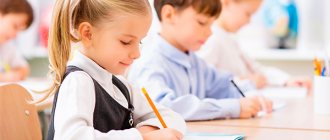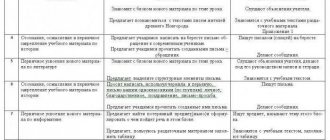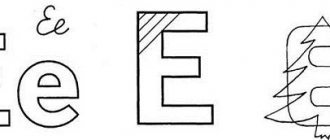Form for Analysis of the Lesson Attended.
Analysis of the lesson attended
Date _________ Teacher ______________ Subject ____________
Number of students according to log_______Actually_____ Late____
1. General characteristics of the lesson
Lesson topic _________________________________________________
Lesson Objectives: Educational_____________________________________________
Educational ________________________________________________
Developmental__________________________________________________________
Lesson objectives: organizational _____________________________________
Information _________________________________________________
Anchorages_______________________________________________________________
Repetitions_______________________________________________________________
Control__________________________________________________________
Corrections______________________________________________________________
Organizational structure of the lesson:
Students' readiness for the lesson (
yes, no
___________________________)
Teacher’s activities in the lesson
(Underline whatever applicable):
Reflection of basic didactic principles in the lesson:
scientific, natural, consistent and systematic, accessible, durable, conscious, active, visual, connection between theory and practice
2.Characteristics of the pedagogical style teacher:
-Proficiency in educational material (yes, no),
-presence of factual errors (present, not present),
- mastery of the demonstration experiment methodology (yes, no),
-organizational abilities and clarity of actions (yes, no, “blurry”),
- general erudition (present, absent, not observed),
- passion and emotionality, pedagogical tact (skills, does not speak) - correctness, literacy and culture of speech (yes, no, there are mistakes)
Methods, techniques and teaching aids in the classroom
Teaching methods :
story, explanation, conversation, lecture, discussion, work with the book, demonstration, illustration, video method, exercise (oral__ .written__, commented___), laboratory method, practical method, test, survey (oral, written, individual, frontal) programmed method control, test control, essay, didactic game__________________
Teaching methods:
reading aloud, drawing up an outline of the text, filling out a table based on the material read, drawing up a logical diagram of what was read, taking notes, selecting quotes,
Teaching aids – material:
textbooks, visual aids (illustrations, dummies, stuffed animals, collection of minerals, didactic material, TSO__________________________________________
Differentiation of learning (no, yes) is manifested in____________________
3Characteristics of the lesson from the point of view of developing students’ general educational skills (underline):
-independently and motivatedly organized cognitive activity of students (from goal setting to obtaining and evaluating results) (yes, no)
-use of elements of cause-and-effect structural-functional, temporal and spatial analysis. (yes, no)
-research of simple real connections and dependencies (no)
- during the lesson, students are given the opportunity to independently create algorithms for cognitive activity to solve problems of a creative and exploratory nature, a prerequisite for this is created (yes, no)
-stimulating the creative activity of students, creating conditions and prerequisites for them to implement their own projects (no)
The nature of students' cognitive activity
: explanatory and illustrative (information receptive), reproductive, problematic presentation, partially search (heuristic), research
Information and communication activities:
—
use of various sources of information in the lesson (yes, no)
-formation of skills related to extracting the necessary information from sources of various sign systems (text, table, graph, diagram,
- formation of skills related to arguing one’s judgments
-use of ICT
-creating situations in the lesson aimed at students mastering the main types of public speaking (monologue, statements, discussion, polemics)
Reflective activity:
-the presence in the lesson of elements of self-control and self-esteem of students, predicting the consequences of their activities, assessing their capabilities (available, not available, ___________)
The presence in the lesson of situations that allow students to correlate the efforts made with the results of their activities (available, not available, ___________)
- formation in the lesson of the skills of joint activities (coordination and coordination of activities with other participants, an objective assessment of one’s contribution to solving common problems of the team, taking into account the individuality of partners) (available, not available, ______________________________)
- the presence of situations in the lesson aimed at assessing and adjusting the behavior of students in the environment, fulfillment of environmental requirements in practical activities and in everyday life; yes, no, ___________)
- the presence in the lesson of situations that contribute to the formation of the student’s own attitude to the phenomena of modern life, the formulation of his worldviews (available, not available, ______________)
-the work of a teacher that facilitates students’ conscious choice of their educational route and future professional activity. (available, not available, ______________)
Students (mastered, did not master) the material, reinforcement exercises (showed, did not show) level of mastery of the material
Setting D\Z
dosed (yes, no), explanation (yes, no)
Psychological environment (friendly, aggressive, indifferent)
Availability of package transformer substations (available, not available)
Correspondence of entries in the journal Topics and KTP (yes, no) Conclusions
_________________________________________________________________________________________________________________________________________________________________________________________________________________________________________________________________
Notes
__________________________________________________________________________________________________________________________________________________________________________________________________________________________________________________________________________________________________________________________________________
Recommendations
_____________________________________________________________________________________________________________________________________________________________________________________________________________________________________________________________________________________________________________________________
I am familiar with the lesson analysis _____________________________________
Lesson Attended _________________________________________________
Self-analysis of the lesson Writing the capital letter I according to the system of L. V. Zankov (1st grade)
Self-analysis of the lesson
literacy training on the topic “Writing the capital letter I”
in 1st grade
Program section
: Letter period
Subject
: Letter of capital letter I
Form:
lesson - journey
Lesson type: lesson on discovering new knowledge Technical equipment of the lesson
:
- Computer, projection screen.
- Visualization for board design;
- Sheets with help for doing independent work; demonstrations of the letter I, for initial writing practice; individual cards for reflection.
Educational and methodological support:
writing notebook No. 4 for grade 1, authors N.V. Nechaeva, N.K. Bulycheva publishing house "Educational Literature" 2012. Teaching methods used in the lesson:
- verbal (story, conversation, explanation),
- explanatory - illustrative (teacher’s presentation, student observations),
- productive method.
Forms of organizing work in the lesson:
- frontal
- steam room
- individual
- collective
Goal of the lesson: developing the skill of writing the capital letter Y.
Objectives:
- formation of graphic skills in writing the letter I and connections with it,
- practice writing words with iotized vowels in three positions: at the beginning of the word, after vowels and after consonants;
- copy from printed text,
— expand the vocabulary of words, continue to work on the development of oral and written speech.
Planned results:
Personal. The student will have the following:
- positive attitude towards learning, educational and cognitive interest, willingness to overcome difficulties;
- aesthetic feelings, incl. a sense of precise, vivid words; the desire for neat, beautiful writing.
Regulatory. The student will learn:
- understand, accept and maintain the learning task;
- act according to plan and plan your actions;
- adequately evaluate your achievements;
— monitor the process and results of activities, make adjustments.
Cognitive. The student will learn:
- be aware of cognitive information;
— structure information, record it in various ways;
- understand information presented in different forms: pictorial, schematic; translate it into verbal form;
- carry out analysis, synthesis, analogy, comparison, classification, generalization;
Communicative. The student will learn:
- participate in dialogue, in general conversation, fulfilling accepted norms of speech behavior and speech culture;
- enter into educational cooperation with the teacher and classmates, carry out joint activities.
Any process of cognition begins with an impulse that encourages action. With this in mind, I carefully thought through each stage of the lesson, composed assignments, selected questions, and used various techniques to enhance student activity. I tried to structure my lesson in accordance with the requirements of the Federal State Educational Standard, taking into account the age and psychological characteristics of students. The stages of the lesson were closely interconnected, various types of activities alternated. Mental actions were based and supported by practical ones. Throughout the lesson, the educational material worked to organize feasible search and research for first-graders and corresponded to their life experience. 1. The beginning of the lesson was organized. With the help of a short poem and an emotional and psychological mood in the greeting, the students became involved in educational and cognitive activities. 2. The next stage of the lesson is self-determination for learning activities, in my opinion, the most important, since at this stage the topic is formulated, the objectives of the lesson are determined, and, most importantly, assessment occurs - the student is highlighting and realizing what has already been learned and what else needs to be learned. The topic and goals of the lesson were determined by the students themselves, based on the corresponding problem situation. 3. At the stage of updating and recording individual difficulties in a trial action, a collective form of work was used, where the functions of a teacher were given to “strong” students, and weak students were given the opportunity to answer questions and show their activity. At this stage, the technique of creating a problem situation was used - a practical task, which the students have not encountered until now. The children realized that a difficulty had arisen in completing the task and that this difficulty must be overcome. 4. The educational goal was the core throughout the lesson. To achieve this goal, students at the project implementation stage demonstrated their ability to find information, analyze it, reason, answer questions, use previously acquired knowledge and developed skills. At the same stage, self-assessment of one’s activities and assessment of work in pairs were used. 5. At the stage of initial consolidation, I, together with the children, identified the area of knowledge and skills in which difficulties were possible. Few mistakes were made. 6. One of the tasks of a primary school teacher is to work on the formation of communicative universal educational actions. At the stage of independent work, I invite students to organize work in pairs; it helps to teach students to express their opinions, defend them, and provide mutual assistance. Also at this stage, children working at a fast pace were provided with differentiated assistance in completing the task without explanation from the teacher. 7. At the stage of summing up the lesson, to develop self-assessment of my work in the lesson, I use the technique of unfinished sentences. These sentences are always before the eyes of children, and they already know how to build phrases according to a given beginning. 8. I pay much attention to the reflection stage in the lesson, since a new learning action will be recorded only when students become aware of the result of their learning activity. The mood at the end of the lesson was assessed. I believe that the goal I set for the lesson was achieved. At all stages of the lesson, students were involved in active thinking and practical activity; children had to not only use existing knowledge, but also find a new way to perform an action they already knew. To change the type of activity, a physical training session was held. In order to consolidate the studied material and develop interest in the topic studied, a creative task was given. There is no homework in 1st grade, but I suggested working with information that they do at home with their parents. One of the requirements for a modern lesson is the use of computer technology. I think that teaching effectiveness is achieved through visualization, so for the lesson I used a fragment of a presentation of writing written letters. The psychological microclimate in the lesson was comfortable: tactful resolution of minor discipline problems, correction of students’ mistakes in the most tactful manner, frequency and variety of forms of verbal encouragement, individual approach and consideration of the psychological characteristics of students.
Expert work
The lesson, which is developed in full accordance with the second generation standards, has serious differences from the traditional form.
Analysis of a lesson according to the Federal State Educational Standard in primary school is based on consideration of the development of universal educational actions in younger schoolchildren. An expert assessing a teacher’s professional activity pays special attention to the teacher’s use of problem-based learning.
Lesson analysis scheme within the framework of the Federal State Educational Standard
Class - 8.
Subject: chemistry.
The author of the textbook is G. E. Rudzitis.
Theme – Water.
The total number of points is 24 points.
Brief performance analysis
The main objectives of the lesson were achieved and implemented during the training session (2 points).
A lesson is presented explaining new material, which has a logical structure and an optimal ratio of stages in time (2 points).
Motivation is provided through the use of demonstration and individual experiments (2 points).
This lesson is focused on the Federal State Educational Standard, didactic principles are observed, and universal learning skills are being formed (2 points).
During the lesson, the teacher uses modern technologies: project and research activities, ICT (2 points).
The lesson material corresponds to the age characteristics of the students (2 points).
There is a connection between theoretical knowledge and its practical application, special attention is paid to independent activity and the development of cognitive activity (2 points).
When developing new skills and abilities, the teacher focuses on previously studied material (2 points).
During the lesson, problematic situations are created for schoolchildren, the teacher formulates special questions aimed at the need for students to make independent decisions (2 points).
The teacher used the method of problem-based learning, a differential approach, project and research activities, and combined tasks of a reproductive nature with creative tasks aimed at developing the logical thinking of schoolchildren (2 points).
Independent work was fully explained and involved searching for information, observation, practical experiments, and comparing the results obtained (2 points).
Throughout the lesson, there was high-quality feedback between students and the mentor, and a comfortable psychological climate (2 points).
Lesson analysis according to Federal State Educational Standards - diagram
What should a lesson analysis according to the Federal State Educational Standard look like? The sample scheme developed for the new educational standards has significant differences from the classical form.
Let us highlight the main points that experts take into account when assessing a modern educational lesson. So, what does lesson analysis according to the Federal State Educational Standard include? The sample for the head teacher presupposes the presence of goals, organizational actions, and types of motivation for schoolchildren. The lesson must fully correspond to the psychological and physiological characteristics and age of the children. An analysis of open lessons according to the Federal State Educational Standard is compiled for a separate lesson (event). On the card, the expert indicates the teacher’s data, the name of the educational institution, the academic subject, the teaching kit, the topic of the lesson, and the date of the lesson.
Filled diagram option
What will a lesson analysis according to the Federal State Educational Standard look like? A sample map will answer this question.
- Basic goals.
The presence of educational, educational, developmental goals of the lesson. To what extent have they been achieved? Were the practical goals that the teacher set for the students realized?
- Lesson organization.
How was the lesson organized? Logic, structure, type, time frame, compliance with the chosen structure of methods for conducting the lesson.
What else does lesson analysis according to the Federal State Educational Standard include? The sample for the head teacher contains a block on the formation of cognitive interest of schoolchildren in the academic discipline being studied.
- Options for motivation used by the teacher during the lesson.
- Compliance of the lesson with the requirements of the second generation educational standards. Focus on the Federal State Educational Standard. Development of universal learning activities. The use of modern pedagogical technologies: design, research, ICT (information and communication technologies).
Basic parameters of a modern lesson
The lesson analysis scheme according to the Federal State Educational Standard includes a point that notes the ability of schoolchildren to independently formulate the topic of the lesson. The main task of the teacher is to lead the children to understand the topic. The teacher only asks clarifying questions, in response to which students correctly formulate the goals of the lesson.
Analysis of a lesson on the Federal State Educational Standard in elementary school contains a plan for achieving the goal set at the beginning of the lesson.
Schoolchildren perform UUD (universal learning activities) according to a plan developed together with the mentor. The teacher organizes frontal, paired, and individual activities.
The lesson analysis scheme according to the Federal State Educational Standard contains a paragraph that notes the teacher’s ability to offer children various options for work, including individual tasks.
Among the distinctive characteristics of the modern lesson from the traditional form, we highlight the presence of mutual control, as well as self-control. Any analysis of a lesson at school according to the Federal State Educational Standard contains reflection. The main errors, shortcomings, and gaps in knowledge identified during self-assessment are eliminated by schoolchildren on their own. The children evaluate not only their own educational achievements, but also analyze the achievements of their classmates.
At the reflection stage, a discussion of the successes achieved, as well as an analysis of the effectiveness of the lesson, is expected.
When preparing homework, the teacher takes into account the individual development of children, selects exercises and tasks of varying levels of complexity, and during the lesson acts as a consultant, giving advice to the children in the process of their independent activities.





